5 Steps to a 5 AP Calculus AB & BC, 2012-2013 Edition (2011)
STEP 4. Review the Knowledge You Need to Score High
Chapter 11. Definite Integrals
IN THIS CHAPTER
Summary: In this chapter, you will be introduced to the summation notation, the concept of a Riemann Sum, the Fundamental Theorems of Calculus, and the properties of definite integrals. You will also be shown techniques for evaluating definite integrals involving algebraic, trigonometric, logarithmic, and exponential functions. In addition, you will learn how to work with improper integrals. The ability to evaluate integrals is a prerequisite to doing well on the AP Calculus exams.

Key Ideas
![]() Summation Notation
Summation Notation
![]() Riemann Sums
Riemann Sums
![]() Properties of Definite Integrals
Properties of Definite Integrals
![]() The First Fundamental Theorem of Calculus
The First Fundamental Theorem of Calculus
![]() The Second Fundamental Theorem of Calculus
The Second Fundamental Theorem of Calculus
![]() Evaluating Definite Integrals
Evaluating Definite Integrals
![]() Improper Integrals
Improper Integrals
11.1 Riemann Sums and Definite Integrals
Main Concepts:
Sigma Notation, Definition of a Riemann Sum, Definition of a Definite Integral, and Properties of Definite Integrals
Sigma Notation or Summation Notation

where i is the index of summation, l is the lower limit and n is the upper limit of summation. (Note: The lower limit may be any non-negative integer ≤ n.)
Examples
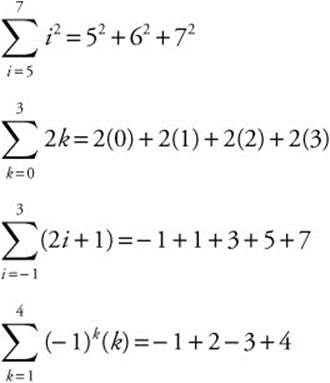
Summation Formulas
If n is a positive integer, then:
1. 
2. 
3. 
4. 
5. 
Example
Evaluate  .
.
Rewrite:
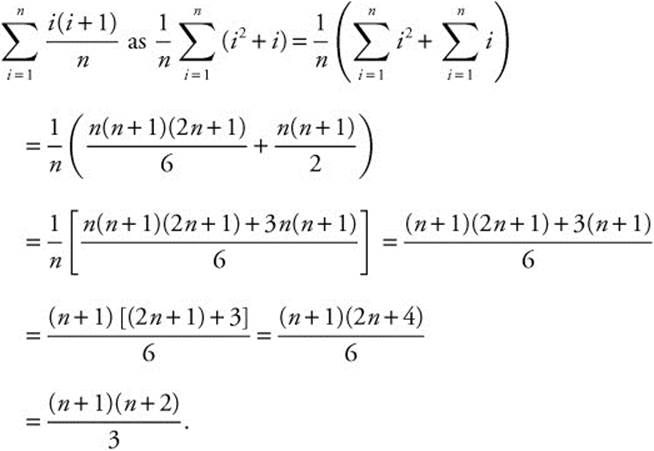
(Note: This question has not appeared in an AP Calculus AB Exam in recent years).

• Remember: In exponential growth/decay problems, the formulas are ![]() and y = y0ekt.
and y = y0ekt.
Definition of a Riemann Sum
Let f be defined on [a, b] and xi be points on [a, b] such that x0 = a, xn = b, and a < x1 < x2 < x3 … < xn−1 < b. The points a, x1, x2, x3, … xn+1, and b form a partition of f denoted as Δ on [a, b]. Let Δxi be the length of the ith interval [xi−1, xi] and ci be any point in the ith interval. Then the Riemann sum of f for the partition is ![]() .
.
Example 1
Let f be a continuous function defined on [0, 12] as shown below.

Find the Riemann sum for f(x) over [0, 12] with 3 subdivisions of equal length and the midpoints of the intervals as ci.
Length of an interval ![]() . (See Figure 11.1-1.)
. (See Figure 11.1-1.)

Figure 11.1-1

The Riemann sum is 596.
Example 2
Find the Riemann sum for f(x) = x3 + 1 over the interval [0, 4] using 4 subdivisions of equal length and the midpoints of the intervals as ci. (See Figure 11.1-2.)

Figure 11.1-2
Length of an interval ![]() ; ci = 0.5 + (i − 1) = i − 0.5.
; ci = 0.5 + (i − 1) = i − 0.5.

Enter Σ ((1 − 0.5)3 + 1, i, 1, 4) = 66.
The Riemann sum is 66.
Definition of a Definite Integral
Let f be defined on [a, b] with the Riemann sum for f over [a, b] written as ![]() . If max Δxi is the length of the largest subinterval in the partition and the
. If max Δxi is the length of the largest subinterval in the partition and the ![]() exists, then the limit is denoted by:
exists, then the limit is denoted by:

 is the definite integral of f from a to b.
is the definite integral of f from a to b.
Example 1
Use a midpoint Riemann sum with three subdivisions of equal length to find the approximate value of ![]() .
.
![]()
midpoints are x = 1, 3, and 5.

Example 2
Using the limit of the Riemann sum, find ![]() .
.
Using n subintervals of equal lengths, the length of an interval
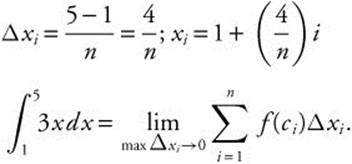
Let ci = xi; max Δxi → 0 ⇒ n → ∞.
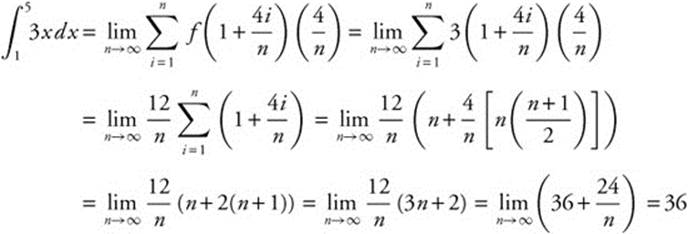
Thus,  .
.
(Note: This question has not appeared in an AP Calculus AB Exam in recent years.)
Properties of Definite Integrals
1. If f is defined on [a, b], and the limit ![]() exists, then f is integrable on [a, b].
exists, then f is integrable on [a, b].
2. If f is continuous on [a, b], then f is integrable on [a, b].
If f (x), g (x), and h(x) are integrable on [a, b], then
3. 
4. 
5.  when C is a constant.
when C is a constant.
6. 
7.  provided f(x) ≥ 0 on [a, b].
provided f(x) ≥ 0 on [a, b].
8.  provided f(x) ≥ g(x) on [a, b].
provided f(x) ≥ g(x) on [a, b].
9. 
10.  ; provided g(x) ≤ f(x) ≤ h(x) on [a, b].
; provided g(x) ≤ f(x) ≤ h(x) on [a, b].
11.  ; provided m ≤ f(x) ≤ M on [a, b].
; provided m ≤ f(x) ≤ M on [a, b].
12.  ; provided f(x) is integrable on an interval containing a, b, c.
; provided f(x) is integrable on an interval containing a, b, c.
Examples
1. 
2. 
3. 
4. 
5. 
Note: Or 
 a, b, c do not have to be arranged from smallest to largest.
a, b, c do not have to be arranged from smallest to largest.
The remaining properties are best illustrated in terms of the area under the curve of the function as discussed in the next section.

• Do not forget that  .
.
11.2 Fundamental Theorems of Calculus
Main Concepts:
First Fundamental Theorem of Calculus, Second Fundamental Theorem of Calculus
First Fundamental Theorem of Calculus
If f is continuous on [a, b] and F is an antiderivative of f on [a, b], then

Note: F(b) − F(a) is often denoted as ![]() .
.
Example 1
Evaluate  .
.

Example 2
Evaluate  .
.

Example 3
If  , k > 0, find k.
, k > 0, find k.


Example 4
If f′(x) = g(x), and g is a continuous function for all real values of x, express  in terms of f.
in terms of f.
Let u = 3x; du = 3dx or ![]() .
.
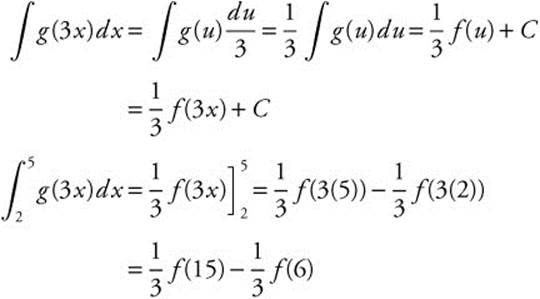
Example 5
Evaluate  .
.
Cannot evaluate using the First Fundamental Theorem of Calculus since ![]() is discontinuous at x = 1.
is discontinuous at x = 1.
Example 6
Using a graphing calculator, evaluate  .
.
Using a TI-89 graphing calculator, enter  and obtain 2π.
and obtain 2π.
Second Fundamental Theorem of Calculus
If f is continuous on [a, b] and  , then F′(x) = f(x) at every point x in [a, b].
, then F′(x) = f(x) at every point x in [a, b].
Example 1
Evaluate  .
.
Let u = 2t; du = 2dt or ![]() .
.
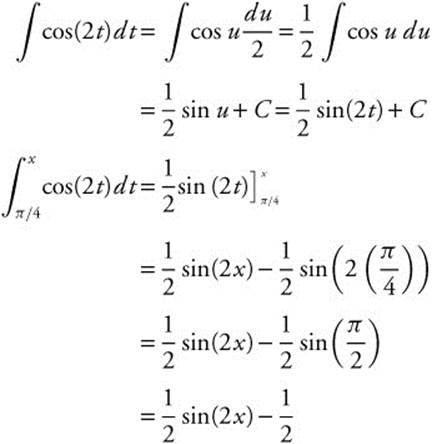
Example 2
If  find h′(8).
find h′(8).
![]()
Example 3
Find ![]() ; if
; if  .
.
Let u = 2x; then ![]() .
.
Rewrite:  .
.

Example 4
Find ![]() ; if
; if  .
.
Rewrite:  .
.
Let u = x2; then ![]() .
.
Rewrite:  .
.

Example 5
Find ![]() if
if  .
.

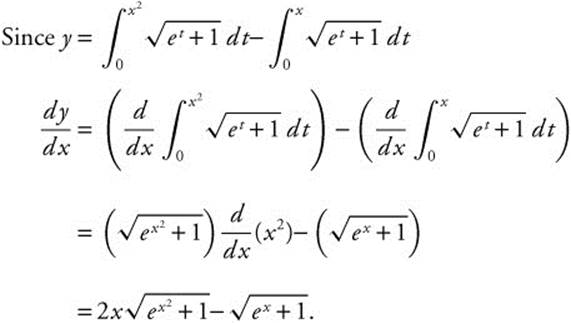
Example 6
 , integrate to find F(x) and then differentiate to find f′(x).
, integrate to find F(x) and then differentiate to find f′(x).
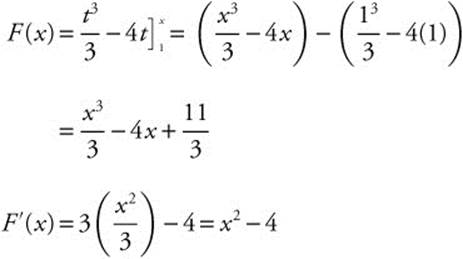
11.3 Evaluating Definite Integrals
Main Concepts:
Definite Integrals Involving Algebraic Functions; Definite Integrals Involving Absolute Value; Definite Integrals Involving Trigonometric, Logarithmic, and Exponential Functions; Definite Integrals Involving Odd and Even Functions

• If the problem asks you to determine the concavity of f′(not f), you need to know if f″ is increasing or decreasing, or if f″′ is positive or negative.
Definite Integrals Involving Algebraic Functions
Example 1
Evaluate  .
.
Rewrite:
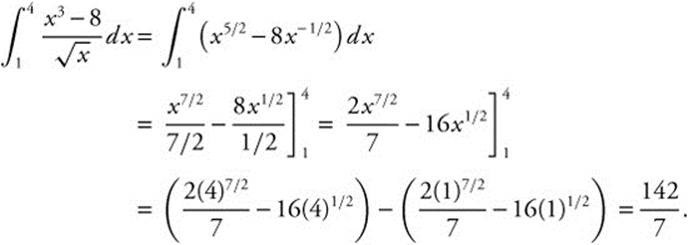
Verify your result with a calculator.
Example 2
Evaluate  .
.
Begin by evaluating the indefinite integral  .
.
Let u = x2 − 1; du = 2x dx or ![]() .
.
Rewrite:  .
.
Thus the definite integral ![]() .
.
Verify your result with a calculator.
Example 3
Evaluate  .
.
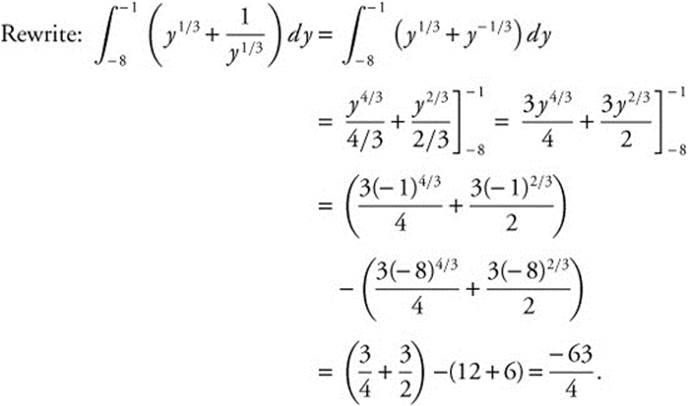
Verify your result with a calculator.

• You may bring up to 2 (but no more than 2) approved graphing calculators to the exam.
Definite Integrals Involving Absolute Value
Example 1
Evaluate  .
.
Set 3x − 6 = 0; x = 2; thus  .
.
Rewrite integral:
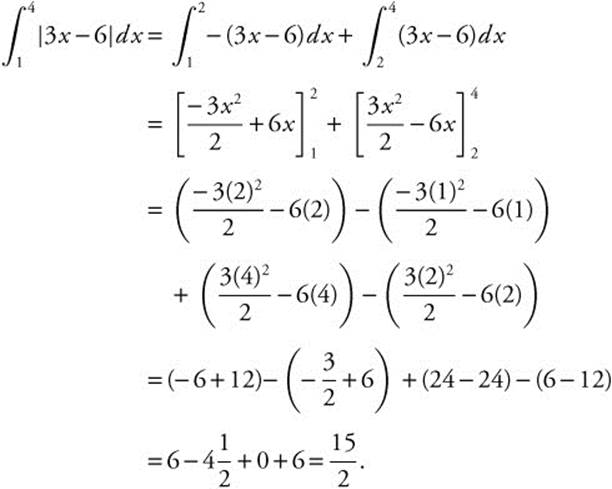
Verify your result with a calculator.
Example 2
Evaluate  .
.
Set x2 − 4 = 0; x = ± 2.
Thus  .
.
Thus,
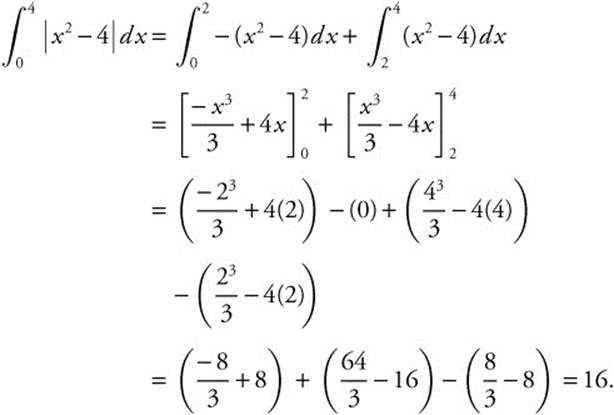
Verify your result with a calculator.

• You are not required to clear the memories in your calculator for the exam.
Definite Integrals Involving Trigonometric, Logarithmic, and Exponential Functions
Example 1
Evaluate  .
.
Rewrite:

Verify your result with a calculator.
Example 2
Evaluate  .
.
Let u = 3t; du = 3dt or ![]() .
.
Rewrite the indefinite integral:
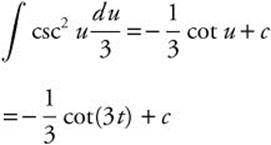
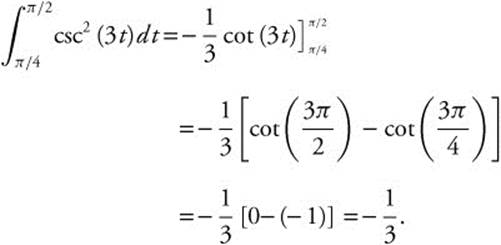
Verify your result with a calculator.
Example 3
Evaluate  .
.
Let u = ln t, ![]() .
.
Rewrite:
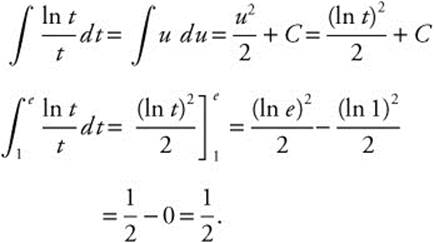
Verify your result with a calculator.
Example 4
Evaluate  .
.
Let u = x2 + 1; du = 2x dx or ![]() .
.

Rewrite:  .
.
Verify your result with a calculator.
Definite Integrals Involving Odd and Even Functions
If f is an even function, that is, f (−x) = f(x), and is continuous on [−a, a], then

If f is an odd function, that is, F(x) = − f(−x), and is continuous on [−a, a] then

Example 1
Evaluate  .
.
Since f(x) = cos x is an even function,

Verify your result with a calculator.
Example 2
Evaluate  .
.
Since f(x) = x4 − x2 is an even function, i.e., f(−x) = f(x), thus

Verify your result with a calculator.
Example 3
Evaluate  .
.
Since f(x) = sin x is an odd function, i.e., f(−x) = − f(x), thus

Verify your result algebraically.

You can also verify the result with a calculator.
Example 4
If  for all values of k, then which of the following could be the graph of f ? (See Figure 11.3-1.)
for all values of k, then which of the following could be the graph of f ? (See Figure 11.3-1.)
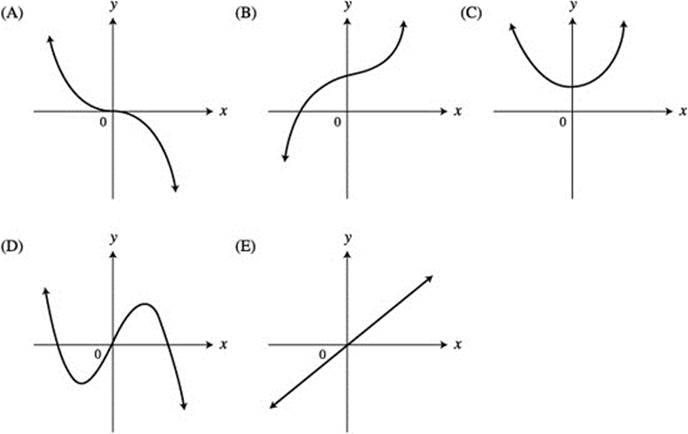
Figure 11.3-1

 , then
, then  .
.
Thus f is an even function. Choice (C).
11.4 Improper Integrals

Main Concepts: Infinite Intervals of Integration, Infinite Discontinuities
Infinite Intervals of Integration
Improper integrals are integrals with infinite intervals of integration or infinite discontinuities within the interval of integration. For infinite intervals of integration,  . If the limit exists, the integral converges.
. If the limit exists, the integral converges.  for some value c.
for some value c.
Example 1
Evaluate  .
.
 so the integral diverges.
so the integral diverges.
Example 2
Evaluate  .
.
Since both limits of integration are infinite, consider the sum of the improper integrals  . This sum is the sum of the limits
. This sum is the sum of the limits ![]() . Since the limit exists, the integral converges and
. Since the limit exists, the integral converges and  .
.
Infinite Discontinuities
If the function has an infinite discontinuity at one of the limits of integration, then  . If an infinite discontinuity occurs at x = c within the interval of integration (a, b), then the integral can be broken into sections at the discontinuity and the sum of the two improper integrals can be found.
. If an infinite discontinuity occurs at x = c within the interval of integration (a, b), then the integral can be broken into sections at the discontinuity and the sum of the two improper integrals can be found. 
Example
Evaluate  .
.
Since ![]() has an infinite discontinuity at
has an infinite discontinuity at ![]() , the integral is improper.
, the integral is improper.
Evaluate ![]() . Since the limit exists,
. Since the limit exists,  .
.
11.5 Rapid Review
1. Evaluate  .
.
Answer: ![]() .
.
2. Evaluate  .
.
Answer: ![]() .
.
3. If  , find G′(4).
, find G′(4).
Answer: G′(x) = (2x + 1)3/2 and G′(4) = 93/2 = 27.
4. If  , find k.
, find k.
Answer: ![]() .
.
5. If G(x) is a antiderivative of (ex + 1) and G(0) = 0, find G(1).
Answer: G(x) = ex + x + C
G(0) = e0 + 0 + C = 0 ⇒ C = −1.
G(1) = e1 + 1 − 1 = e.
6. If G′(x) = g(x), express  .
.
Answer: Let u = 4x ![]() .
.
 . Thus
. Thus  .
.
7. 
Answer:  .
.
8. 
Answer:  .
.
11.6 Practice Problems
Part A—The use of a calculator is not allowed.
Evaluate the following definite integrals.
1. 
2. 
3. 
4. 
5. If  , find k.
, find k.
6. 
7. If f′(x) = g(x) and g is a continuous function for all real values of x, express  in terms of f.
in terms of f.
8. 
9. 
10. If  , find
, find ![]() .
.
11. 
12. 
Part B—Calculators are allowed.
13. Find k if 
14. Evaluate  to the nearest 100th.
to the nearest 100th.
15. If  , find
, find ![]() .
.
16. Use a midpoint Riemann sum with four subdivisions of equal length to find the approximate value of  .
.
17. Given 
and  , find
, find
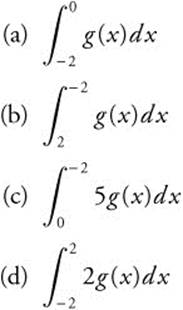
18. Evaluate  .
.
19. Find  .
.
20. Let f be a continuous function defined on [0, 30] with selected values as shown below:

Use a midpoint Riemann sum with three subdivisions of equal length to find the approximate value of  .
.

21. 
22. 
23. 
24. 
25. 
11.7 Cumulative Review Problems
(Calculator) indicates that calculators are permitted.
26. Evaluate  .
.
27. Find ![]() at x = 3 if y = ln|x2 − 4|.
at x = 3 if y = ln|x2 − 4|.
28. The graph of f′, the derivative of f, −6 ≤ x ≤ 8 is shown in Figure 11.7-1.
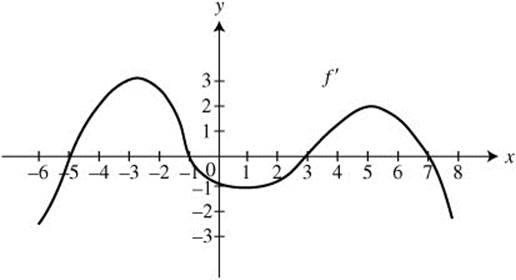
Figure 11.7-1
(a) Find all values of x such that f attains a relative maximum or a relative minimum.
(b) Find all values of x such that f is concave upward.
(c) Find all values of x such that f has a change of concavity.
29. (Calculator) Given the equation 9x2 + 4y2 − 18x + 16y = 11, find the points on the graph where the equation has a vertical or horizontal tangent.
30. (Calculator) Two corridors, one 6 feet wide and another 10 feet wide meet at a corner. (See Figure 11.7-2.) What is the maximum length of a pipe of negligible thickness that can be carried horizontally around the corner?
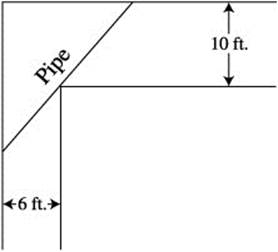
Figure 11.7-2
31. Evaluate ![]() .
.
32. Determine the speed of an object moving along the path described by x = 3 − 2t2, y = t2 + 1 when ![]() .
.
33. 
11.8 Solutions to Practice Problems
Part A—The use of a calculator is not allowed.
1.
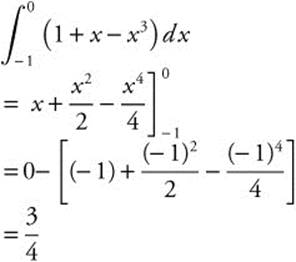
2. Let u=x − 2 du = dx.
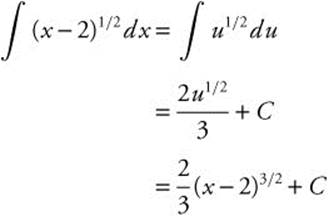
Thus
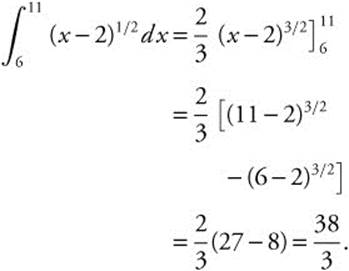
3. Let u = t + 1 du = dt and t = u − 1.
Rewrite:
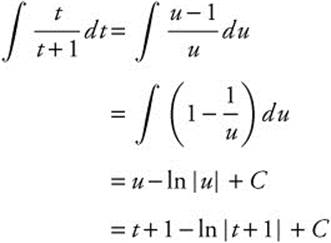
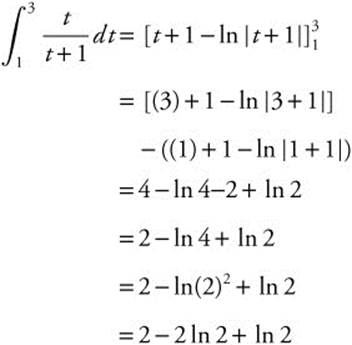
= 2 − ln 2.
4. Set x − 3 = 0; x = 3.
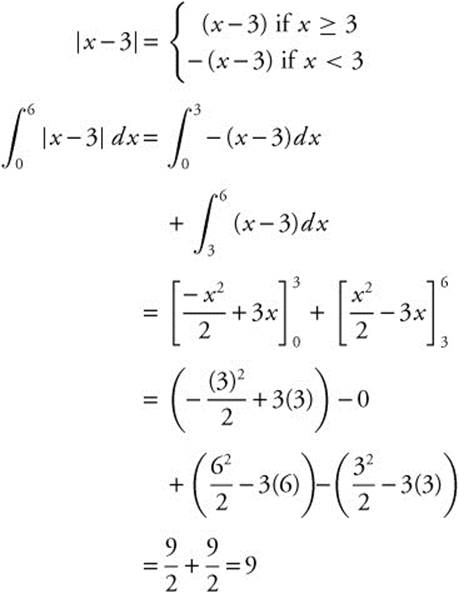
5. 
Set 3k2 − k = 4 ⇒ 3k2 − k − 4 = 0
⇒ (3k − 4)(k + 1) = 0
⇒ ![]() or k = −1
or k = −1
Verify your results by evaluating
 and
and  .
.
6. Let u = 1 + cos x; du = −sin x dx or − du = sin x dx.
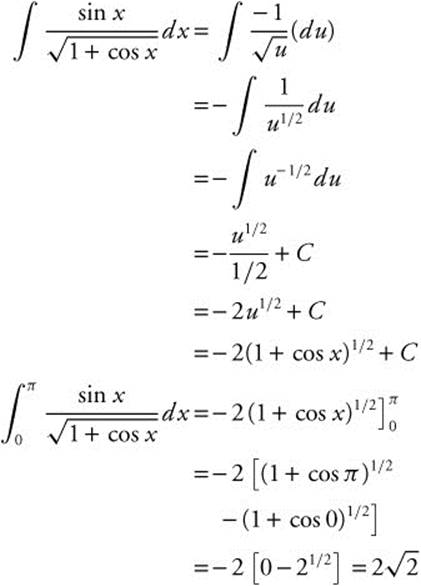
7. Let u = 4x; du = 4 dx or ![]() .
.
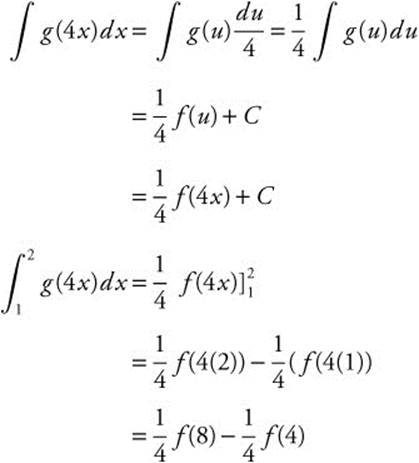
8.
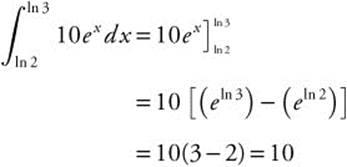
9. Let u = t + 3; du = dt.
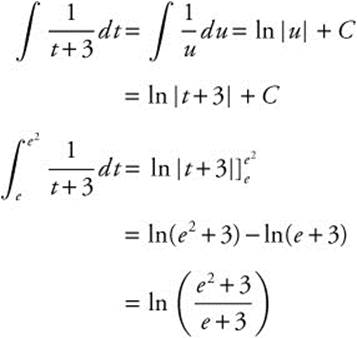
10. f′(x) = tan2 x;

11. Let u = x2; du = 2x dx or ![]() .
.
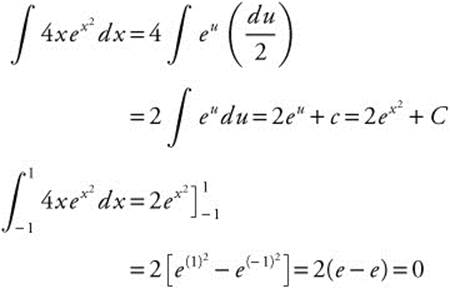
Note that f(x) = 4x![]() is an odd function.
is an odd function.
Thus,  .
.
12.
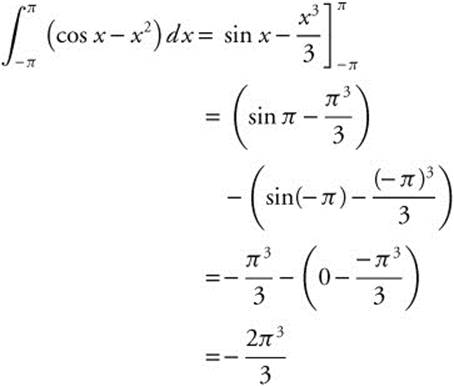
Note that f(x) = cosx − x2 is an even function. Thus, you could have written  and obtained the same result.
and obtained the same result.
Part B—Calculators are allowed.
13.
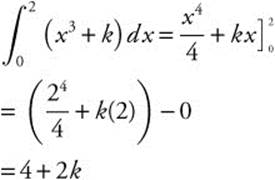
Set 4 + 2k = 10 and k = 3.
14. Enter  , x, −1.2, 3.1) and obtain −4.70208 ≈ −4.702.
, x, −1.2, 3.1) and obtain −4.70208 ≈ −4.702.
15.
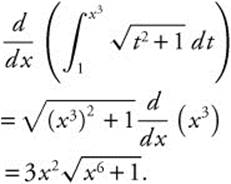
16. ![]()
Midpoints are x = 1, 3, 5, and 7.
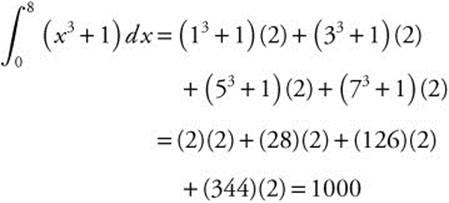
17.
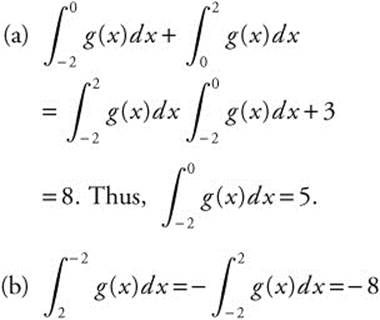
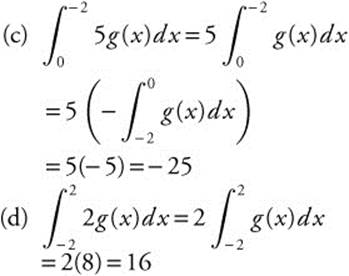
18.
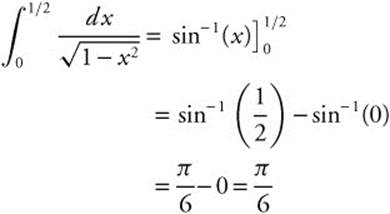
19.
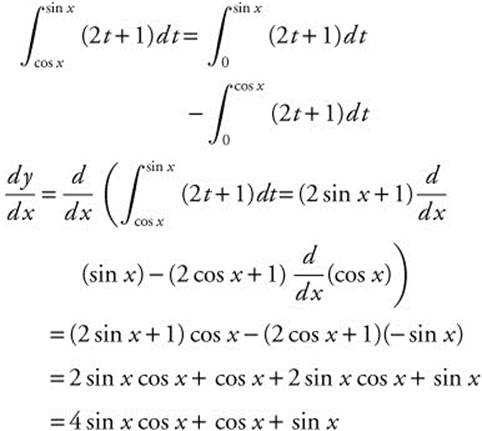
20. ![]()
Midpoints are x = 5, 15, and 25.

21.
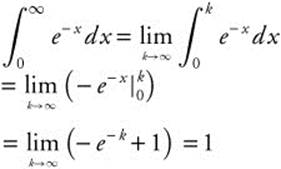
22.
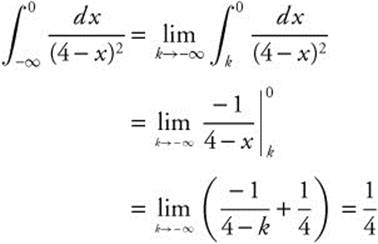
23.
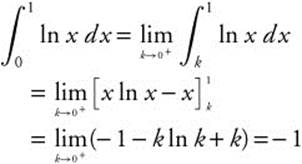
24.
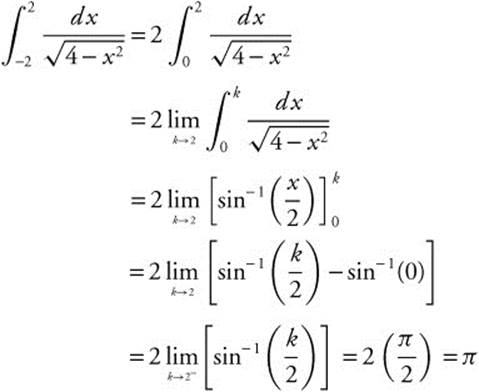
25.
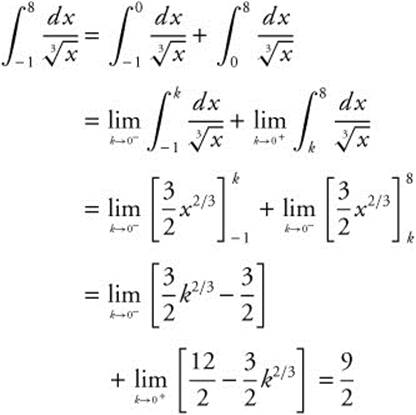
11.9 Solutions to Cumulative Review Problems
26.
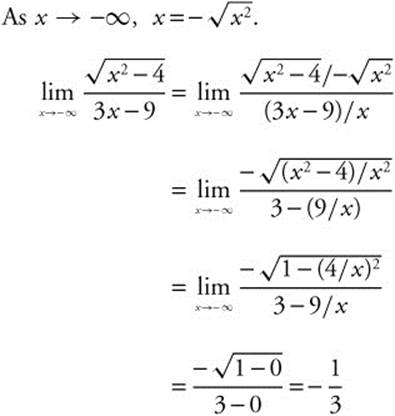
27.
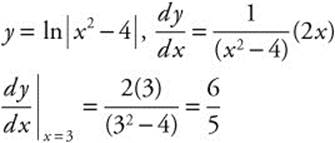
28. (a) (See Figure 11.9-1.)
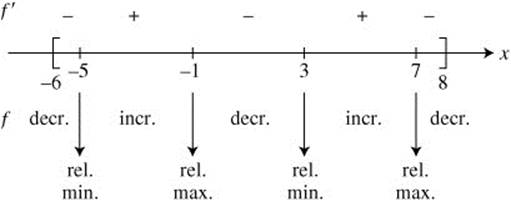
Figure 11.9-1
The function f has a relative minimum at x = −5 and x = 3, and f has a relative maximum at x = −1 and x = 7.
(b) (See Figure 11.9-2.)
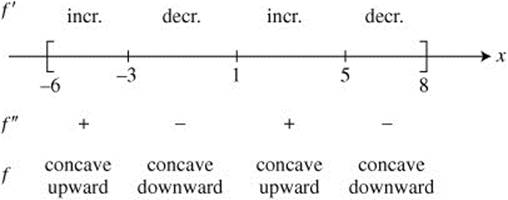
Figure 11.9-2
The function f is concave upward on intervals (−6, −3) and (1, 5).
(c) A change of concavity occurs at x = −3, x = 1, and x = 5.
29. (Calculator) Differentiate both sides of
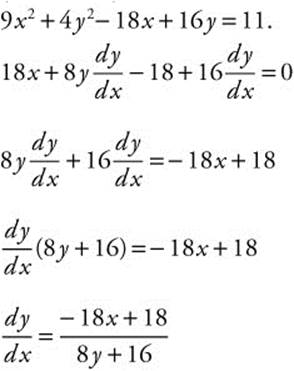
Horizontal tangent ![]() .
.
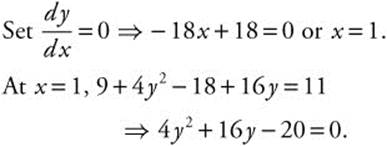
Using a calculator, enter [Solve] (4y^2 + 16y − 20 =0, y); obtaining y = −5 or y = 1.
Thus at each of the points at (1, 1) and (1, −5) the graph has a horizontal tangent. Vertical tangent ![]() is undefined.
is undefined.
Set 8y + 16 = 0 ⇒ y = −2.
At y = −2, 9x2 + 16 − 18x − 32 = 11
⇒ 9x2 − 18x − 27 = 0.
Enter [Solve] (9x2 − 8x − 27 = 0, x) and obtain x = 3 or x = −1.
Thus, at each of the points (3, −2) and (−1, −2), the graph has a vertical tangent. (See Figure 11.9-3.)
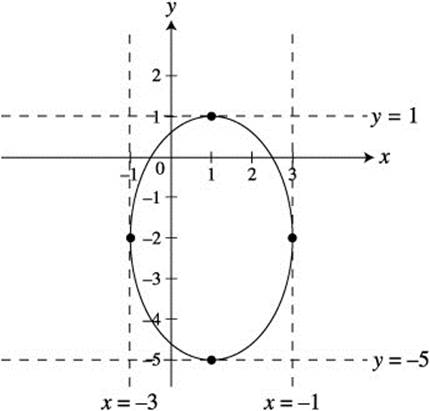
Figure 11.9-3
30. (Calculator)
Step 1. (See Figure 11.9-4.) Let P = x + y where P is the length of the pipe and x and y are as shown. The minimum value of P is the maximum length of the pipe to be able to turn in the corner. By similar triangles, ![]() and thus,
and thus, 

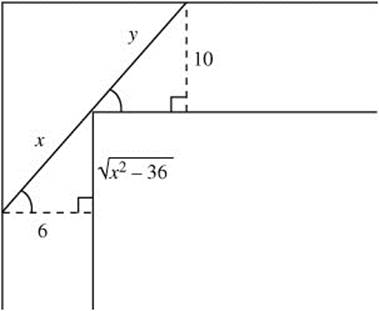
Figure 11.9-4
Step 2. Find the minimum value of P. Enter ![]() . Use the [Minimum] function of the calculator and obtain the minimum point (9.306, 22.388).
. Use the [Minimum] function of the calculator and obtain the minimum point (9.306, 22.388).
Step 3. Verify with the First Derivative Test.
Enter y 2 = (y1(x), x) and observe. (See Figure 11.9-5.)
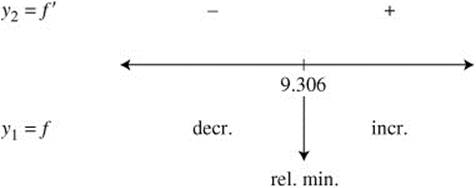
Figure 11.9-5
Step 4. Check endpoints. The domain of x is (6, ∞). Since x = 9.306 is the only relative extremum, it is the absolute minimum.
Thus the maximum length of the pipe is 22.388 feet.
31.
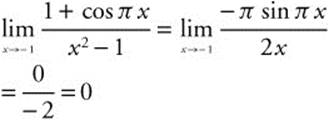
32. ![]() . The speed of the object is
. The speed of the object is ![]() . Evaluated at
. Evaluated at ![]() , the speed is
, the speed is  .
.
33. Integrate  by parts with u = 2x, du = 2dx,
by parts with u = 2x, du = 2dx, ![]() , and
, and ![]() . Then
. Then  . Simplifying this expression, we get
. Simplifying this expression, we get  .
.